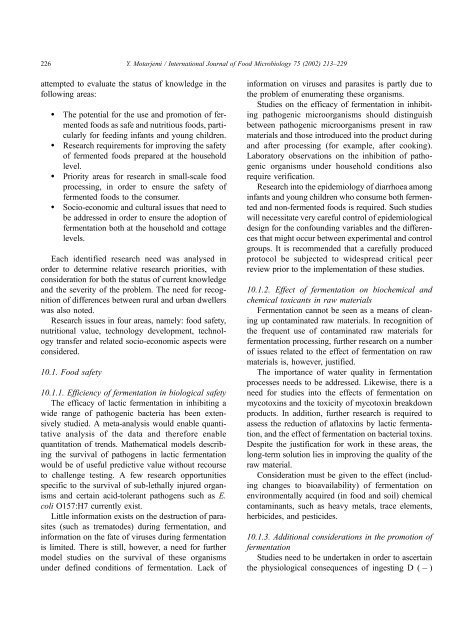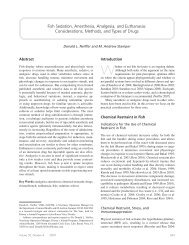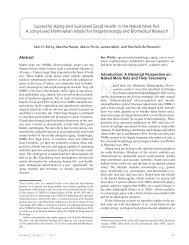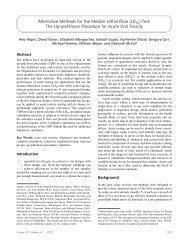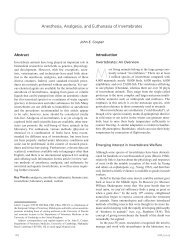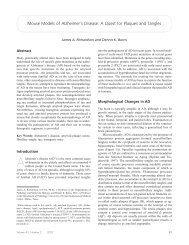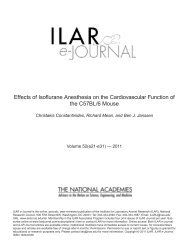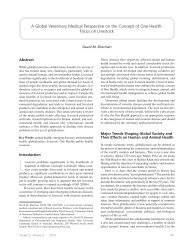Impact of small scale fermentation technology on food safety in ...
Impact of small scale fermentation technology on food safety in ...
Impact of small scale fermentation technology on food safety in ...
Create successful ePaper yourself
Turn your PDF publications into a flip-book with our unique Google optimized e-Paper software.
226<br />
attempted to evaluate the status <str<strong>on</strong>g>of</str<strong>on</strong>g> knowledge <strong>in</strong> the<br />
follow<strong>in</strong>g areas:<br />
The potential for the use and promoti<strong>on</strong> <str<strong>on</strong>g>of</str<strong>on</strong>g> fermented<br />
<strong>food</strong>s as safe and nutritious <strong>food</strong>s, particularly<br />
for feed<strong>in</strong>g <strong>in</strong>fants and young children.<br />
Research requirements for improv<strong>in</strong>g the <strong>safety</strong><br />
<str<strong>on</strong>g>of</str<strong>on</strong>g> fermented <strong>food</strong>s prepared at the household<br />
level.<br />
Priority areas for research <strong>in</strong> <str<strong>on</strong>g>small</str<strong>on</strong>g>-<str<strong>on</strong>g>scale</str<strong>on</strong>g> <strong>food</strong><br />
process<strong>in</strong>g, <strong>in</strong> order to ensure the <strong>safety</strong> <str<strong>on</strong>g>of</str<strong>on</strong>g><br />
fermented <strong>food</strong>s to the c<strong>on</strong>sumer.<br />
Socio-ec<strong>on</strong>omic and cultural issues that need to<br />
be addressed <strong>in</strong> order to ensure the adopti<strong>on</strong> <str<strong>on</strong>g>of</str<strong>on</strong>g><br />
<str<strong>on</strong>g>fermentati<strong>on</strong></str<strong>on</strong>g> both at the household and cottage<br />
levels.<br />
Each identified research need was analysed <strong>in</strong><br />
order to determ<strong>in</strong>e relative research priorities, with<br />
c<strong>on</strong>siderati<strong>on</strong> for both the status <str<strong>on</strong>g>of</str<strong>on</strong>g> current knowledge<br />
and the severity <str<strong>on</strong>g>of</str<strong>on</strong>g> the problem. The need for recogniti<strong>on</strong><br />
<str<strong>on</strong>g>of</str<strong>on</strong>g> differences between rural and urban dwellers<br />
was also noted.<br />
Research issues <strong>in</strong> four areas, namely: <strong>food</strong> <strong>safety</strong>,<br />
nutriti<strong>on</strong>al value, <str<strong>on</strong>g>technology</str<strong>on</strong>g> development, <str<strong>on</strong>g>technology</str<strong>on</strong>g><br />
transfer and related socio-ec<strong>on</strong>omic aspects were<br />
c<strong>on</strong>sidered.<br />
10.1. Food <strong>safety</strong><br />
Y. Motarjemi / Internati<strong>on</strong>al Journal <str<strong>on</strong>g>of</str<strong>on</strong>g> Food Microbiology 75 (2002) 213–229<br />
10.1.1. Efficiency <str<strong>on</strong>g>of</str<strong>on</strong>g> <str<strong>on</strong>g>fermentati<strong>on</strong></str<strong>on</strong>g> <strong>in</strong> biological <strong>safety</strong><br />
The efficacy <str<strong>on</strong>g>of</str<strong>on</strong>g> lactic <str<strong>on</strong>g>fermentati<strong>on</strong></str<strong>on</strong>g> <strong>in</strong> <strong>in</strong>hibit<strong>in</strong>g a<br />
wide range <str<strong>on</strong>g>of</str<strong>on</strong>g> pathogenic bacteria has been extensively<br />
studied. A meta-analysis would enable quantitative<br />
analysis <str<strong>on</strong>g>of</str<strong>on</strong>g> the data and therefore enable<br />
quantitati<strong>on</strong> <str<strong>on</strong>g>of</str<strong>on</strong>g> trends. Mathematical models describ<strong>in</strong>g<br />
the survival <str<strong>on</strong>g>of</str<strong>on</strong>g> pathogens <strong>in</strong> lactic <str<strong>on</strong>g>fermentati<strong>on</strong></str<strong>on</strong>g><br />
would be <str<strong>on</strong>g>of</str<strong>on</strong>g> useful predictive value without recourse<br />
to challenge test<strong>in</strong>g. A few research opportunities<br />
specific to the survival <str<strong>on</strong>g>of</str<strong>on</strong>g> sub-lethally <strong>in</strong>jured organisms<br />
and certa<strong>in</strong> acid-tolerant pathogens such as E.<br />
coli O157:H7 currently exist.<br />
Little <strong>in</strong>formati<strong>on</strong> exists <strong>on</strong> the destructi<strong>on</strong> <str<strong>on</strong>g>of</str<strong>on</strong>g> parasites<br />
(such as trematodes) dur<strong>in</strong>g <str<strong>on</strong>g>fermentati<strong>on</strong></str<strong>on</strong>g>, and<br />
<strong>in</strong>formati<strong>on</strong> <strong>on</strong> the fate <str<strong>on</strong>g>of</str<strong>on</strong>g> viruses dur<strong>in</strong>g <str<strong>on</strong>g>fermentati<strong>on</strong></str<strong>on</strong>g><br />
is limited. There is still, however, a need for further<br />
model studies <strong>on</strong> the survival <str<strong>on</strong>g>of</str<strong>on</strong>g> these organisms<br />
under def<strong>in</strong>ed c<strong>on</strong>diti<strong>on</strong>s <str<strong>on</strong>g>of</str<strong>on</strong>g> <str<strong>on</strong>g>fermentati<strong>on</strong></str<strong>on</strong>g>. Lack <str<strong>on</strong>g>of</str<strong>on</strong>g><br />
<strong>in</strong>formati<strong>on</strong> <strong>on</strong> viruses and parasites is partly due to<br />
the problem <str<strong>on</strong>g>of</str<strong>on</strong>g> enumerat<strong>in</strong>g these organisms.<br />
Studies <strong>on</strong> the efficacy <str<strong>on</strong>g>of</str<strong>on</strong>g> <str<strong>on</strong>g>fermentati<strong>on</strong></str<strong>on</strong>g> <strong>in</strong> <strong>in</strong>hibit<strong>in</strong>g<br />
pathogenic microorganisms should dist<strong>in</strong>guish<br />
between pathogenic microorganisms present <strong>in</strong> raw<br />
materials and those <strong>in</strong>troduced <strong>in</strong>to the product dur<strong>in</strong>g<br />
and after process<strong>in</strong>g (for example, after cook<strong>in</strong>g).<br />
Laboratory observati<strong>on</strong>s <strong>on</strong> the <strong>in</strong>hibiti<strong>on</strong> <str<strong>on</strong>g>of</str<strong>on</strong>g> pathogenic<br />
organisms under household c<strong>on</strong>diti<strong>on</strong>s also<br />
require verificati<strong>on</strong>.<br />
Research <strong>in</strong>to the epidemiology <str<strong>on</strong>g>of</str<strong>on</strong>g> diarrhoea am<strong>on</strong>g<br />
<strong>in</strong>fants and young children who c<strong>on</strong>sume both fermented<br />
and n<strong>on</strong>-fermented <strong>food</strong>s is required. Such studies<br />
will necessitate very careful c<strong>on</strong>trol <str<strong>on</strong>g>of</str<strong>on</strong>g> epidemiological<br />
design for the c<strong>on</strong>found<strong>in</strong>g variables and the differences<br />
that might occur between experimental and c<strong>on</strong>trol<br />
groups. It is recommended that a carefully produced<br />
protocol be subjected to widespread critical peer<br />
review prior to the implementati<strong>on</strong> <str<strong>on</strong>g>of</str<strong>on</strong>g> these studies.<br />
10.1.2. Effect <str<strong>on</strong>g>of</str<strong>on</strong>g> <str<strong>on</strong>g>fermentati<strong>on</strong></str<strong>on</strong>g> <strong>on</strong> biochemical and<br />
chemical toxicants <strong>in</strong> raw materials<br />
Fermentati<strong>on</strong> cannot be seen as a means <str<strong>on</strong>g>of</str<strong>on</strong>g> clean<strong>in</strong>g<br />
up c<strong>on</strong>tam<strong>in</strong>ated raw materials. In recogniti<strong>on</strong> <str<strong>on</strong>g>of</str<strong>on</strong>g><br />
the frequent use <str<strong>on</strong>g>of</str<strong>on</strong>g> c<strong>on</strong>tam<strong>in</strong>ated raw materials for<br />
<str<strong>on</strong>g>fermentati<strong>on</strong></str<strong>on</strong>g> process<strong>in</strong>g, further research <strong>on</strong> a number<br />
<str<strong>on</strong>g>of</str<strong>on</strong>g> issues related to the effect <str<strong>on</strong>g>of</str<strong>on</strong>g> <str<strong>on</strong>g>fermentati<strong>on</strong></str<strong>on</strong>g> <strong>on</strong> raw<br />
materials is, however, justified.<br />
The importance <str<strong>on</strong>g>of</str<strong>on</strong>g> water quality <strong>in</strong> <str<strong>on</strong>g>fermentati<strong>on</strong></str<strong>on</strong>g><br />
processes needs to be addressed. Likewise, there is a<br />
need for studies <strong>in</strong>to the effects <str<strong>on</strong>g>of</str<strong>on</strong>g> <str<strong>on</strong>g>fermentati<strong>on</strong></str<strong>on</strong>g> <strong>on</strong><br />
mycotox<strong>in</strong>s and the toxicity <str<strong>on</strong>g>of</str<strong>on</strong>g> mycotox<strong>in</strong> breakdown<br />
products. In additi<strong>on</strong>, further research is required to<br />
assess the reducti<strong>on</strong> <str<strong>on</strong>g>of</str<strong>on</strong>g> aflatox<strong>in</strong>s by lactic <str<strong>on</strong>g>fermentati<strong>on</strong></str<strong>on</strong>g>,<br />
and the effect <str<strong>on</strong>g>of</str<strong>on</strong>g> <str<strong>on</strong>g>fermentati<strong>on</strong></str<strong>on</strong>g> <strong>on</strong> bacterial tox<strong>in</strong>s.<br />
Despite the justificati<strong>on</strong> for work <strong>in</strong> these areas, the<br />
l<strong>on</strong>g-term soluti<strong>on</strong> lies <strong>in</strong> improv<strong>in</strong>g the quality <str<strong>on</strong>g>of</str<strong>on</strong>g> the<br />
raw material.<br />
C<strong>on</strong>siderati<strong>on</strong> must be given to the effect (<strong>in</strong>clud<strong>in</strong>g<br />
changes to bioavailability) <str<strong>on</strong>g>of</str<strong>on</strong>g> <str<strong>on</strong>g>fermentati<strong>on</strong></str<strong>on</strong>g> <strong>on</strong><br />
envir<strong>on</strong>mentally acquired (<strong>in</strong> <strong>food</strong> and soil) chemical<br />
c<strong>on</strong>tam<strong>in</strong>ants, such as heavy metals, trace elements,<br />
herbicides, and pesticides.<br />
10.1.3. Additi<strong>on</strong>al c<strong>on</strong>siderati<strong>on</strong>s <strong>in</strong> the promoti<strong>on</strong> <str<strong>on</strong>g>of</str<strong>on</strong>g><br />
<str<strong>on</strong>g>fermentati<strong>on</strong></str<strong>on</strong>g><br />
Studies need to be undertaken <strong>in</strong> order to ascerta<strong>in</strong><br />
the physiological c<strong>on</strong>sequences <str<strong>on</strong>g>of</str<strong>on</strong>g> <strong>in</strong>gest<strong>in</strong>g D ( )


